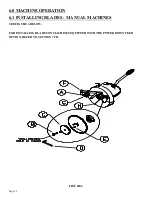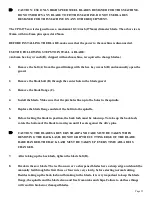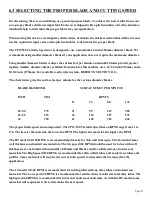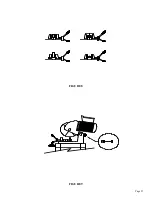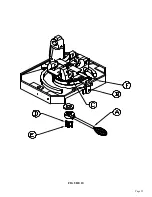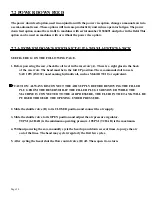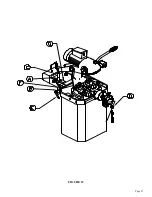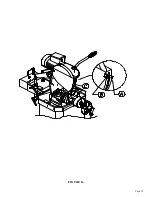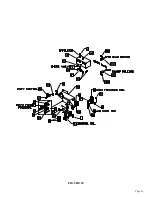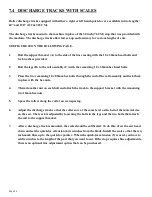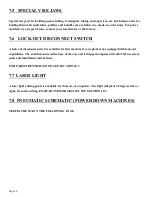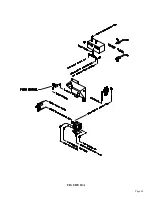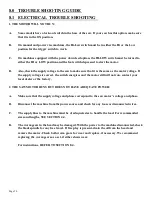
Page 36
7.2B STROKE CONTROL ADJUSTMENT (POWER DOWN FEED)
SEE FIGURE 15 ON THE FOLLOWING PAGE.
Before powering the machine, the up and down strokes of the saw head must be set. The stroke is set by
the collars (A & B) on the shaft (C).
TO SET THE STROKE:
1.
Without powering the saw, cycle the head down by depressing the foot switch, with the HI-Low
switch in the OFF position. If this switch is in either the HI or Low position, the saw motor will
start when the pedal is depressed.
2.
Close the flow control (D) down so that the head travels down slowly. When the blade reaches the
point where it will cut through the material, close the flow control valve (D) and the head will stop
at that point.
3.
Loosen the handle (E) on the collar (B) and slide the collar up until it contacts the limit switch (F).
4.
Slowly release the flow control knob and allow the head to return until the blade is just high
enough that the material will feed under the blade. Then, close the flow control valve.
5.
Loosen the handle on the upper collar (A) and slide the collar down until it contacts the limit
switch (G).
6.
To make sure that the settings are correct, open the flow control valve (D) and cycle the head
several times before powering the machine.
⌦
CAUTION: ANY TIME THAT THE BLADE OR THE SIZE OF THE MATERIAL BEING
CUT IS CHANGED, THE STROKE OF THE MACHINE HAS TO BE CHECKED. FAILURE
TO SET THE STROKE OF THE MACHINE WILL RESULT IN DAMAGE TO THE
MACHINE OR TO THE BLADES.
7.
Adjust the flow control valve (D) to the proper cutting feed rate before cutting any material.
The lubricating device should produce a drop of oil every 5 to 10 cycles. It can be adjusted by the
knob on top of the lubricator. There is a clear plastic dome on top of the lubricator with a copper
tube inside. The oil should drop from the copper tube. The oil in the lubrication device should be
checked everyday. The oil level in the reservoir should be checked every week. For recommended
fluids, REFER TO SECTION 5.2.
As with all other functions of the saw, selection of the proper blade, spindle speed and clamping
are very important in providing a quality finished product.
Summary of Contents for CPO-275
Page 8: ...Page 7 FIGURE 1...
Page 10: ...Page 9 FIGURE 2...
Page 13: ...Page 12 MANUAL OR PK W TRIGGER SWITCH FIGURE 3 1...
Page 14: ...Page 13 PKPD W EMERGENCY STOP FIGURE 3 2...
Page 15: ...Page 14 1 PHASE MOTOR W TRIGGER SWITCH FIGURE 3 3...
Page 16: ...Page 15 1 PHASE MOTOR W E STOP SERIAL S B3431 UP FIGURE 3 4...
Page 22: ...Page 21 FIGURE 5A...
Page 28: ...Page 27 FIGURE 8 FIGURE 9...
Page 30: ...Page 29 FIGURE 10...
Page 36: ...FIGURE 14 Page 35 C A B D...
Page 38: ...Page 37 FIGURE 15...
Page 40: ...Page 39 FIGURE 16...
Page 42: ...Page 41 FIGURE 17...
Page 44: ...Page 43 FIGURE 18...
Page 46: ...Page 45 FIGURE 19...
Page 48: ...Page 47 FIGURE 20...
Page 50: ...Page 49 FIGURE 20A...
Page 58: ...Page 57 FIGURE 23...
Page 60: ...FIGURE 24 Page 59...
Page 62: ...Page 61 G 078000 60 RPM 230 Volt 1 Phase T S 078001 60 RPM 230 Volt 1 Phase E S FIGURE 25...
Page 66: ...Page 65 FIGURE 27...
Page 68: ...Page 67 FIGURE 28...
Page 70: ...Page 69 FIGURE 29...
Page 74: ...Page 73 FIGURE 31...
Page 76: ...Page 75 FIGURE 32...
Page 78: ...Page 77 FIGURE 33...
Page 80: ...FIGURE 34 Page 79...
Page 82: ...Page 81 FIGURE 35...
Page 84: ...Page 83 FIGURE 36...
Page 86: ...Page 85 FIGURE 37...
Page 88: ...Page 87 FIGURE 38...
Page 90: ...Page 89 FIGURE 39...

